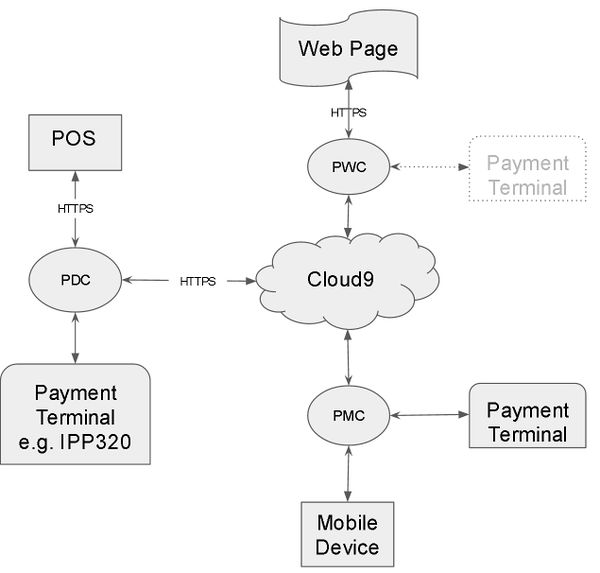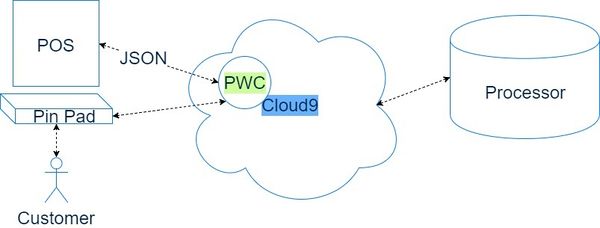Difference between revisions of "Template:PDC"
(→Payment Device Controller Setup) |
|||
| (7 intermediate revisions by the same user not shown) | |||
| Line 1: | Line 1: | ||
| − | Optional Payment Device Controller (PDC) hides the complexity of low level communications with the payment terminals and adds | + | Optional [[Cloud9_Payment_Device_Controller_Setup|Payment Device Controller]] (PDC) hides the complexity of low level communications with the payment terminals and adds [[Offline Store & Forward]] functionality, if desired. |
The client (POS/web page/mobile device, etc) can communicate with the PDC, which will in turn control the payment perminal/pin pad and relate the processing instructions to the Cloud9 Payment Gateway. | The client (POS/web page/mobile device, etc) can communicate with the PDC, which will in turn control the payment perminal/pin pad and relate the processing instructions to the Cloud9 Payment Gateway. | ||
This is the easiest form of integration and it is recommended. | This is the easiest form of integration and it is recommended. | ||
<br>Note: Variations of Payment Device Controller are Payment Mobile Controller (PMC) and Payment Web Controller (PWC), dealing with mobile and web based payment processing functionality respectively. | <br>Note: Variations of Payment Device Controller are Payment Mobile Controller (PMC) and Payment Web Controller (PWC), dealing with mobile and web based payment processing functionality respectively. | ||
| + | '''→ OPTION1: Local Payment Device Controller with Store and Forward Capability''' | ||
<br> | <br> | ||
| Line 10: | Line 11: | ||
|[[File:PDCClientCloud.jpg|none|600px|Main Cloud9 Payment Processing Gateway Integration Diagram]] | |[[File:PDCClientCloud.jpg|none|600px|Main Cloud9 Payment Processing Gateway Integration Diagram]] | ||
|- | |- | ||
| − | |The client can communicate | + | |The client can communicate with a local Payment Device Controller (PDC) via SOAP, JSON or using the wizard like wrapper, written in C/C++/Java. |
|} | |} | ||
| + | |||
| + | '''→ OPTION2: No Local Software - Direct Cloud Connection to Cloud9 Payment Web Controller (PWC)''' | ||
| + | |||
| + | {| style=" border: 1px dashed red; width="600px" | ||
| + | |- style="vertical-align: top;" | ||
| + | |[[File:CloudPWCDirect.jpg|none|600px|Cloud9 PWC Direct Integration Diagram]] | ||
| + | |- | ||
| + | |The client can communicate directly with the cloud Payment Web Controller (PWC) via SOAP, JSON or using the wizard like wrapper, written in C/C++/Java. | ||
| + | |} | ||
| + | |||
| + | |||
| + | ==Payment Device Controller Setup== | ||
| + | Please, see '''[[Cloud9_Payment_Device_Controller_Setup|Cloud9 Payment Device Controller Setup]]''' | ||
Latest revision as of 21:11, 6 June 2018
Optional Payment Device Controller (PDC) hides the complexity of low level communications with the payment terminals and adds Offline Store & Forward functionality, if desired.
The client (POS/web page/mobile device, etc) can communicate with the PDC, which will in turn control the payment perminal/pin pad and relate the processing instructions to the Cloud9 Payment Gateway.
This is the easiest form of integration and it is recommended.
Note: Variations of Payment Device Controller are Payment Mobile Controller (PMC) and Payment Web Controller (PWC), dealing with mobile and web based payment processing functionality respectively.
→ OPTION1: Local Payment Device Controller with Store and Forward Capability
| The client can communicate with a local Payment Device Controller (PDC) via SOAP, JSON or using the wizard like wrapper, written in C/C++/Java. |
→ OPTION2: No Local Software - Direct Cloud Connection to Cloud9 Payment Web Controller (PWC)
| The client can communicate directly with the cloud Payment Web Controller (PWC) via SOAP, JSON or using the wizard like wrapper, written in C/C++/Java. |
Payment Device Controller Setup
Please, see Cloud9 Payment Device Controller Setup

